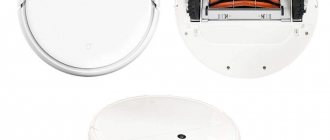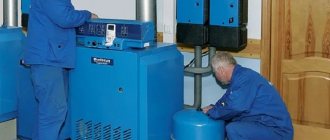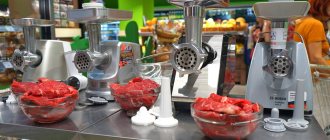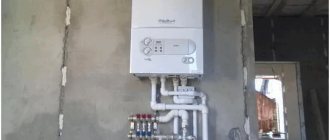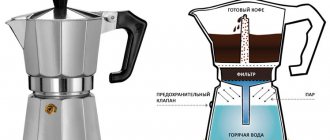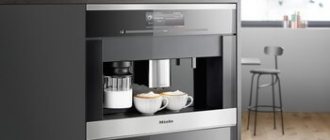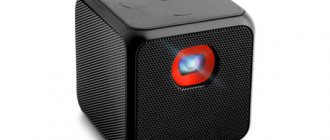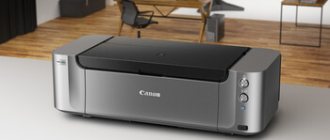Grinding coffee beans directly affects the taste of the finished drink, so devices designed for grinding them deserve special attention .
Manufacturers offer a variety of manual and electric devices that can cope with the task, however, in order to decide which model to choose, it is worth familiarizing yourself with the features of each type, their advantages and disadvantages .
Page navigation:
Varieties
There are only three types of coffee grinders , which are determined by grinding systems:
- Rotary . They are a compact body with an internal engine. At the top of the appliance body there is a small compartment for coffee beans, which are ground using a rotating blade . There is no separate container for ground coffee in rotary coffee grinders. The device holds a small amount of raw materials, but this is quite enough to provide an invigorating drink for a family of five.
- Millstones . The design of burr coffee grinders is a little more complicated than rotary models: inside the body there are two stainless steel disks, between which the beans are ground . The grinding amount in such a device can be adjusted depending on the distance at which the millstones are located. Electric millstone models are equipped with two containers for pouring in the product and obtaining it in crushed form , which helps prevent powder from scattering throughout the kitchen.
- Mechanical . A device with a simple operating principle. To grind grains, the user needs to pour them into the compartment and start turning the handle without connecting to the network. In manual models, the degree of grain grinding is adjusted with a screw, so the grind can be made a little finer or coarser. The main thing in a mechanical product is the quality of all components and a comfortable handle that can withstand the pressure exerted on it .
Important! According to their intended purpose, electric coffee grinders can be household, professional and industrial. For home use, the first option is the most suitable in all respects.
Blade electric coffee grinder
In such coffee grinders, raw materials are ground using knives mounted on a rod, which break the coffee beans at high speed. The body of the devices is made of plastic (metal models are also produced). Inside the case there is a motor, and in the upper part there is a container for coffee beans. The rotary knife is made in the form of a two-bladed propeller; as a rule, it is made of stainless steel. It is located at the very bottom of the tank and is connected to the motor. The top of the case is covered with a transparent, removable lid. When the beans are ground, the lid is opened and the coffee is poured out of the container. The capacity of knife coffee grinders is usually no more than 120 g.
Rotary models do not have a mechanism for controlling the degree of grinding. Usually it depends on the duration of action of the rotary knives (the longer they rotate, the finer the grinding, but it is unlikely that it will be possible to achieve a uniform degree of grinding).
Power
When rotating at high speed, the knife grinds the grains; the quality of grinding directly depends on the time of its rotation. And the rotation speed is directly dependent on the power of the motor in the coffee grinder, which can be from 80 to 270 W. The optimal power in this case is considered to be 180 W.
If the grinding speed of the beans is too high (and therefore at high power), the beans may become charred and the coffee will acquire a bitter taste.
Advantages and disadvantages
Coffee grinders are equipped with containers for filling coffee, with a volume of 30 to 100 g. This must be taken into account, since on average 6-7 g of ground coffee are used for one cup of drink. It is not recommended to make a large supply, as coffee quickly loses its taste and smell. For example, 30 g is enough for 3 cups of aromatic drink.
The advantages of knife coffee grinders include:
- Relatively low cost.
- Compactness.
- Easy to use.
The disadvantages include:
- Lack of control over grinding degree.
- Uneven grinding of coffee beans.
Coffee of this grind can also be brewed in a Turk. But if you are thinking about which coffee grinder is best to buy for subsequent preparation of a drink in a coffee maker, it is better to opt for millstone models.
Electric rotary
Rotary or blade-type coffee grinders work on the principle of a blender , quickly grinding coffee beans to the desired size.
The device does not have a large volume (usually it ranges from 30 to 120 g) and a variety of functions. There is only a pulsed operating mode, characterized by constant stops at certain intervals.
The body of the electrical appliance can be plastic or metal. Plastic models are cheaper, however, less durable . Stainless steel products will last much longer, but you will have to pay a higher price for them.
The power indicator in rotary models varies from 80 to 270 W. When the knives rotate intensively, the coffee becomes very hot, losing its aromatic and taste properties, so of 180 W.
Advantages
- low price;
- the ability to grind coffee beans, spices, nuts;
- ease of use;
- compact size;
- anti-slip feet;
- removable knives;
- almost silent operation;
- light weight;
- maintainability.
Flaws
- uneven grinding;
- lack of a dispenser for poured grains;
- inability to control the quality of the powder;
- lack of a separate container for crushed product;
- The coffee grinder is inconvenient to clean;
- fragile plastic parts of the case;
- The protruding sharp parts of the knives can cut your fingers.
Who are they suitable for?
A rotary coffee grinder is perfect for people who love and appreciate good coffee brewed in a Turk, but do not prepare it often.
The chamber of the rotary device contains a small amount of coffee beans , which is why you will have to grind them to prepare several servings of the drink every day.
For users who actively drink coffee throughout the day, such a device will not be the most successful purchase.
Briefly about the rotary type
In a rotary coffee grinder, the containers into which the beans are poured for grinding are equipped with knives. When the machine is turned on, these knives rotate quickly and chop the grains. The degree of grinding depends on its duration. To make the particles smaller, you need to grind a little longer.
Very effective option for quick grinding
When choosing a rotary coffee grinder, you need to consider the following characteristics:
- Motor power . This figure varies from 100 W to 270 W. Often, the larger the volume of the loading container, the greater the power of the coffee grinder. The optimal power is 180 W. But a device with a power of 130 W will also grind grains well, only the process may last a couple of seconds longer. If the power of the appliance is too high, the beans may char and the coffee will have an unpleasant bitter taste.
- Material of the device body. The service life of the device largely depends on the material. Plastic parts often break. More durable – stainless steel coffee grinders. But they are more expensive than plastic models.
- Container capacity. Containers come in capacities from 40 to 120 grams. For one serving of espresso, the standard requires 7 grams of coffee. There is no dispenser in the device, so you need to measure the required amount of grains yourself. It is not recommended to store coffee in a container for longer than half an hour. Otherwise, it will not differ from the purchased ground one, and some of the aroma will disappear. Ideally, you should grind your coffee before preparing it.
You may also be interested in information about what a Turkish coffee maker looks like and how it is used, and how to choose the best planetary mixer.
The video shows how to use the device correctly:
Rotary coffee grinders can be equipped with additional functions:
- Double knives will increase the grinding speed.
- A tilted bowl will ensure uniformity and intensity of grinding.
- The grind adjustment dial will adjust the grind (coarse, medium or fine).
- Overheat protection. The motor automatically turns off when overheated, so it will not burn out, thus increasing the service life of the device.
Most rotary coffee grinders have an activation lock when the lid is open. The device will not turn on until the lid is closed tightly. This important feature protects your hands from injury and prevents coffee from spilling.
You may also be interested in information on how to brew coffee beans.
Some models have a device for winding the cord; it can also be automatic, which makes the device more convenient to use. Check this feature when purchasing the device. The cord should be wound evenly and not snag. Make sure that the length of the cord suits you.
You may also be interested in information about what a delonghi carob coffee maker with cappuccino maker looks like.
Pros of a rotary coffee grinder:
- Convenient to use for grinding small amounts of grains.
- Compactness. Its small size and weight make it easy to take it with you if necessary. Doesn't take up much space in the kitchen.
- Affordable price.
Cons of a rotary coffee grinder:
- Inhomogeneity of grinding.
- Lack of dispenser. You need to determine the required portion of grains yourself and add them manually. Usually 1 tbsp is used for one cup of coffee. l. (without top) grains.
- Beans and ground coffee are in one container. It is inconvenient to pick up the powder because of the knives. It is better to choose a model with a removable container to make it convenient to pour out the ground coffee.
- The motor burns out quite quickly, usually after one year of service. Cannot be repaired.
- Plastic parts of the case often break.
- They are not suitable for grinding other products, for example, cereals, peppers, nuts, because they cannot be washed well, the smell will remain and will affect the taste and aroma of coffee.
You may also be interested in information on how to choose a coffee machine for your home with a cappuccino maker.
Electric millstones
Electric burr coffee grinders have a large reservoir for coffee beans and provide high quality grinding . The millstones in the grinder are durable steel discs, and the grinding thickness is adjusted using the selected program. Up to 300 g of grains are placed in the container .
There are two types of millstones in burr-type coffee grinders: cylindrical and conical . Unlike cylindrical ones, devices with conical millstones have high power and a long service life, so consumers most often choose this option.
The average power of millstone models is 250-300 W, which is quite enough for domestic use.
Advantages
- large selection of working programs;
- optimal tank volume;
- possibility of grinding adjustment;
- high-quality uniform grinding;
- safety;
- the device does not heat the grains;
- ease of cleaning;
- ergonomic design;
- the device copes with heavy loads;
- preservation of the taste and aroma of grains;
- availability of additional functions.
Flaws
- the coffee grinder takes up a lot of space;
- noisy work;
- high price.
Who are they suitable for?
An electric burr coffee grinder will become an indispensable assistant in quickly preparing various coffee-based drinks in a coffee maker, electric Turk or coffee machine.
The device is also suitable for grinding coffee for further brewing in a cup - this is the easiest option for preparing an aromatic drink without the use of coffee machines.
What does grind size affect?
The degree of coffee grinding is one of the most important factors affecting the taste, aroma and quality of the finished coffee drink.
Using a burr coffee grinder, you can achieve any degree of grinding of beans and independently regulate the richness of coffee brewed in various ways..
Pros and cons of electric models
An electric coffee grinder is a useful invention of progress that allows you to save time on processing coffee beans.
The advantages of the device include the following:
- High speed of grain processing. It is enough to connect the device to the power supply and start the grinding mechanism. In just a few seconds, the output will be a powder that is suitable for brewing in a cup or cooking in a Turk.
- Large price range. On sale you can find both expensive multifunctional models and budget ones, the purchase of which will cost a couple of tens of dollars.
- Easy to use. You can learn to use an electric coffee grinder in one go - its operation is elementary and does not require any special user skills.
- Ergonomics. By choosing a compact model, you can easily find a place for it even in a small kitchen or quickly take it out of a cabinet.
The unit also has disadvantages:
- Dependence on power source. You will need to place the coffee grinder close to an outlet, and if there is a power outage, you may be left without coffee altogether.
- Fixed grain tank. This is the problem with inexpensive knife devices. It is inconvenient to remove the ground powder from the bowl due to the open arrangement of the knives.
- Possibility of getting bitter coffee. High-power coffee grinders heat the beans, so the prepared drink may taste bitter.
- Low maintainability. Electrical appliances often break down, it is not always possible to repair them, which means you will have to spend money on a new device.
- Grinding degree. Only expensive electric coffee grinders have a grinding degree control function.
Hand millstones
Mechanical coffee grinders are the most popular and common devices for grinding coffee beans.
The operating principle of manual models is no different from electric millstone machines.
Attention! The main advantage of a mechanical device is that it does not need to be connected to an electrical outlet.
The millstones of a manual coffee grinder are made of ceramic, stainless steel or cast iron. Cast iron ones are considered inexpensive and durable - they are designed to process 0.5 kg of grains . The body of the device can be made of wood, ceramic or metal.
Manual burr-type coffee grinders carefully and thoroughly grind beans with maximum preservation of their unique aroma.
Advantages
- careful processing of the product;
- uniform grinding of grains;
- possibility of adjusting the degree of grinding;
- the device does not burn grains during processing;
- presence of a container for ground coffee;
- simple design;
- compact size and light weight;
- ease of care;
- low noise level;
- reasonable price.
Flaws
- grinding grains by hand;
- costs of time and energy;
- small size container for grains;
- To change the degree of grinding, you need to remove the fixing screw.
Who are they suitable for?
A manual coffee grinder has many advantages over using electric models, however, working with a mechanical device requires time and effort , which is why the coffee grinder is not suitable for busy people.
Choosing a manual model should be for those who live in a measured rhythm and can devote a few minutes to grinding grains by hand.
What types of coffee grinders are there, their features
Modern electric coffee grinders on the market mainly fall into two categories:
- Knife (rotary). They are a device with a plastic or metal body, in the lower part of which there is a motor, and in the upper part there is a reservoir for coffee, closed with a tight lid. Grinding of coffee beans in a coffee grinder of this type is carried out by rapidly rotating stainless steel knives mounted on a metal rod.
- Millstones (millstones). Models of this type grind coffee beans using screw discs made of stainless steel, cast iron or ceramic. The device consists of a compartment with a motor and millstones, as well as two containers, into one of which coffee beans are loaded, and into the other the already ground product is poured. The grain reservoir in mill models is usually quite large and can hold up to 300 g of grains. The power of the device can range from 100 to 1000 W, but the optimal figure is within 300 W.
How to choose a coffee grinder for your home?
When choosing a coffee grinder for your home, you need to check the following characteristics :
- Power . The powerful device only takes a few seconds to grind the coffee into powder, but often the intense grinding leaves the coffee with a bitter aftertaste. For this reason, experts recommend choosing models with a power of 160-180 W.
- Capacity . Freshly ground coffee does not retain its flavor and aroma properties for long, so the container for beans should not be too large. However, if you are buying a coffee grinder for a large family or office, it is better to choose a burr model that can grind a large number of beans at a time.
- Safety . The coffee grinder should not be turned on with the lid loosely closed or open to prevent ground coffee from spilling, and should also have anti-slip feet for stability during operation.
- Case material . Unlike plastic devices, metal structures are more stable and durable.
In electric models, you need to pay attention to the button to turn on the device .
If it does not stick and is comfortable to press, you can safely buy the product.
Electric burr grinder
Unlike blade or rotary models, burr coffee grinders use a different grinding method, namely burrs. The degree of grinding is quite uniform; this coffee is good for use in pressure coffee machines. The body of the millstones is also made of plastic. It contains:
- transparent container for filling coffee beans;
- transparent container for ready-made ground coffee;
- opaque compartment with electric motor.
All parts of the coffee grinder are closed with sealed lids and separated from each other.
The device works simply:
- When you press the power button located on the control panel, the millstones begin to grind grains at high speed.
- The ground particles enter the lower compartment intended for them, from where they can be collected into the cup.
The mechanism of burr electric coffee grinders consists of two disks (millstones) that grind coffee beans. The grind size can be adjusted independently, and it depends on the distance between these two disks.
Ground coffee prepared in a burr grinder can be brewed in any coffee makers and coffee machines.
These models have a larger capacity than knife models - up to 300 g of coffee beans. The devices have about 15 modes for grinding grains, i.e. The resulting ground coffee is quite homogeneous.
Advantages of millstones:
- Using a special program, you can dose the amount of grinding.
- Their cost is of course higher, but it is compensated by the presence of additional useful functions.
Additional functions
For ease of use, manufacturers equip coffee grinders with additional functions. Among them :
- Protection against overheating or foreign objects - if the machine overheats or a stone or piece of branch accidentally gets into it, the operation will stop, which will protect the coffee grinder from damage and the user from drinking a low-quality drink.
- Timer for setting the grinding time of grains - allows you to set the duration of grinding the product.
- Display – it displays all the necessary data about the state of the device.
- Cord winder – makes the electrical device compact and easy to store.
- Double knives – increase the speed of grinding coffee beans several times.
- Sound insulation – ensures quieter operation of the electrical appliance when used in the morning, when all family members are still sleeping.
Criteria for choosing a manual coffee grinder
For a manual coffee grinder, such parameters as the quality of the millstones and body, as well as the location of the handle, the presence of a grain hopper, etc. are important.
Housing material
The body is made of ceramics, porcelain, plastic, metal and wood. The durability of the device depends on the characteristics of the material.
The body of a manual coffee grinder can be made of wood.
Ceramic and porcelain models are aesthetically pleasing and easy to clean, but even a slight impact is often enough to damage the body. European-style coffee grinders are most often made of wood. They are durable, but quickly absorb the flavor of the beans.
Turkish-type devices are often made of brass or copper. Plastic models are lightweight, easy to use and inexpensive.
Handle location
On most mechanical coffee grinders, the handle is located at the top. However, models with the handle on the side are more convenient, because Such devices are characterized by better stability.
Millstone material
The material from which the millstones are made affects not only the durability of the device, but also the taste of the finished product.
Most often, the grinding mechanism is made from:
- cast iron;
- become;
- ceramics;
- stone
The material from which the millstones are made affects durability.
Coffee grinders with cast iron burrs are inexpensive, but absorb odors well. Steel products are practical, but can be worn down during use. Ceramic millstones gently grind grains, but require careful handling, because... quite fragile. Stone millstones are durable and ensure gentle grinding of coffee.
Adjusting the grinding degree
To correct the degree of grinding, change the size of the millstone gap. More often, correction is carried out using a rotating mechanism. In oriental hand-held instruments, adjustment of the distance between the disks is ensured by a screw.
Powder container
In all case-based manual devices, the powder collection container is located at the bottom. It is important that when grinding, all particles fall into it and dust does not remain in the space between this container and the body.
Grain hopper
In most manual models it is located on top. Its capacity is 10–50 g. In rare cases, it is represented by a separate compartment in the upper part of the device above the millstones. The volume of such a depression reaches 50–200 g.
The bean hopper is located on top of the coffee grinder.
Useful video
From this video you will learn more about how to choose the right model for preparing your favorite drink:
With the right choice of coffee grinder, even a person far from culinary will be able to prepare a tasty and rich coffee drink.
Having decided to purchase a device for grinding coffee beans, you must first study information about all types of coffee grinders and decide on the functions that must be present in the device - this will help you choose the right model without overpaying for unnecessary options.
Purpose and functions
Purpose – grinding coffee beans and other products.
Functions:
- blocking switching on when the lid is not closed;
- pulse mode, which promotes uniform grinding of microgranules;
- overheating protection system – automatic shutdown of the coffee grinder when the engine heats up to the required temperature;
- dispenser function to ensure high-quality and uniform grinding;
- grinding degree control;
- grinding nuts, spices, cereals, powdered sugar.
Rotary electric coffee grinders
Rotary electric coffee grinders are also called knife grinders, since the knife is responsible for grinding.
The longer the device operates, the finer the grind becomes. But the grain crumbs are of different sizes. If you prepare this kind of coffee in a Turk, everything will be delicious. But for a coffee machine and coffee maker, heterogeneous grinding is not suitable: the extraction of beans will become uneven, which will ruin the taste of the drink.
Note that in some models of rotary coffee grinders you can adjust the grinding degree. This way you will achieve a more homogeneous mass.
Most rotary coffee grinders only have one blade. But there are models with two choppers. They work faster and better. True, sometimes they fail due to overheating.
Many large manufacturers, like VITEK or Royal kuchen, make coffee grinders with one blade, but curved at the edges. This is an important point, without which the grinding would become completely uneven.
The rotary type of electric coffee grinders is worth buying for those who are looking for an inexpensive compact product for Turkish coffee or grinding nuts, spices, etc.
Electric burr grinders
In burr coffee grinders, grinding is performed by two discs. The size of the coffee grains depends on how close they are pressed to each other. Millstones always have a grinding degree regulator. Even in budget options, like the Vitek VT-7122 coffee grinder.
Millstones are canonical and flat.
In the first version, one cone-shaped element is located inside another. The external one is always fixed. Only the inner one moves. The grains, falling between the cones, move downward in a spiral and are gradually crushed.
The second (flat) model looks like two threaded washers that are located on top of each other. Coffee beans are ground, falling into the cavities between the discs.
This electric coffee grinder is worth buying for those who want to get a uniform grind and adjust its size. But as a future buyer, keep in mind that the millstones will “crunch” loudly.
The main disadvantage of burr coffee grinders is that they are often counterfeited
All baristas and coffee lovers claim that burr grinders are the best. However, they do not talk about one of their nuances - the quality of execution. In modern home appliance stores and online coffee grinder stores, you can buy a pseudo-burr copy. This is something very similar to a regular burr grinder, only with significant differences in the details.
Manufacturers call their products “millstones,” thereby misleading inexperienced buyers. But anyone who wants to understand the truth can identify a fake.
The first thing you should pay attention to is the price of the coffee grinder.
Most pseudo-millstone products cost no more than 5-6 thousand rubles. Whereas you can buy real electric burr coffee grinders only for 8-12 thousand, and then more.
The second thing to do is look at the mechanism.
Pseudo-millstone devices have flat millstones, but with irregular threads. The teeth will protrude noticeably. Coffee beans, after entering the mechanism, will begin to crumble and crush, rather than grind smoothly. As a result, there will be uneven grains in the container (this is especially noticeable when setting the grind to coarse).
But, despite the disadvantages, these coffee grinders for home are produced and sold in large volumes. In some ways, they are better than rotary ones, since they always have adjustment of the degree of grinding and the amount of coffee during a single start.
Many craftsmen “modify” pseudo-millstone devices. There is a lot of information on the Internet on improving millstones. Anyone who can use a screwdriver and scissors can do it.
So, a pseudo-burr coffee grinder may be quite enough for the owner of a standard carob or geyser coffee maker if he is ready to accept not the highest grinding quality and does not want something more in the future. For the money, the product is more productive than a manual coffee grinder.
Types of coffee grinders
There are several types of devices designed for grinding grains. The choice of one or another of them largely depends on the frequency of the planned grinding and the purpose of the purchase. An antique coffee grinder is ideal as an original gift. If the unit will be constantly in use, you need to pay attention to more advanced models.
Manual
This coffee grinder for home use is now quite rare. Often it plays a decorative role, giving the kitchen a special look. It takes at least a quarter of an hour to process the grains, which are enough for just one serving. Nevertheless, sometimes people still prefer this budget model.
Those who use hand-held devices find many advantages in them. During their operation, it is possible to relieve tension. Unlike electric options, the sound of manual ones is not annoying. Also, some are convinced that the powder obtained in such units has a richer aroma.
Electric millstones
The millstone model has a pair of metal discs between which the grains are ground. The powder is homogeneous. This is an excellent Turkish coffee grinder. It is also used when grinding coffee beans for espresso.
The size of the fractions is adjustable. Modern designs make it possible to choose up to fifteen grinding options. The unit crushes up to three hundred grams of raw materials at a time. True, such devices are considered the most expensive.
Electric rotary
A rotary coffee grinder has sharp blades that cut coffee beans into fractions. True, it will not be possible to obtain a uniform grind using this device. Some particles will be larger than all the rest.
The degree of grinding is regulated by the duration of grinding. The longer the unit is turned on, the finer the powder produced. A blade coffee grinder allows you to obtain powder for cezve. Also, the resulting fractions can be used in coffee makers.

